Nail psoriasis is a type of disease that mainly affects the skin. Like other types of pathology, this form has a chronic, non-infectious process and is recurrent. The main signs of damage to nail plates by psoriasis are deformation, loss of gloss, appearance of spots on the plate, and complete detachment of the nail.
In this shape, the skin around the disc also suffers. Premature and improper treatment can cause complications such as severe deformities and complete loss of nails on the hands and feet.
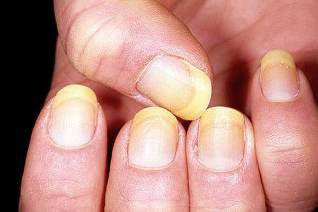
Treating psoriasis of the hand nail is similar to other treatments, but has its own characteristics. In this article, we examine the symptoms, causes and treatment of nails and nails.
Nail damage in psoriasis can occur for a variety of reasons. Often this form is found in the background of this form of pathology, such as arthritis of psoriasis.
In medical practice, this type of nail is called psoriasis or psoriatic onychodystrophy. It is quite rare, but often has complications and many unwanted symptoms.
The following provocative factors can be attributed to the main causes of the pathology:
- common stress and emotional stress;
- improper metabolic processes in the body;
- chronic infectious diseases;
- poor circulation;
- nail damage and exposure to certain chemicals;
- genetic predisposition.
Important! In some patients, nail psoriasis occurs as a result of damage to the nail plates caused by a bacterial infection. In such cases, it is quite difficult to diagnose the disease, an experienced professional should identify the disease.
Varieties
Psoriasis under the nail can occur in patients of different ages, but in most cases occurs in patients older than 35-40 years. There are several forms of the disease. These are:
Thimble Syndrome
This type is characterized by the loss of the board in the form of point draws. They are most often localized to a certain area of the nail, but there are often cases where the furrows cover the entire nail. Externally, the disc resembles a thimble, so this type is often referred to as a "thimble. "
Onicolysis
This shape has symptoms such as fading of the nail, loss of color. This is due to the lack of microcirculation in healthy blood. As the disease develops, the disc becomes distorted and disappears. Only a small portion of the disk remains on the base.
Bleeding appears
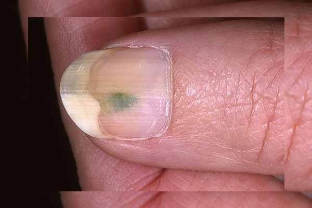
Causes the formation of red or pink spots under the nails. These symptoms occur at the beginning of the pathology. In addition, signs such as bruises may appear under the disc. It has the seal of the nail, it also has a layer.
How to distinguish nail psoriasis or fungus?
Patients are often interested in how to distinguish nail fungus from psoriasis. This issue is quite complex and requires consultation with a professional. Laboratory tests are also required. Methods such as biopsy of dermis samples as well as histological examinations help to exclude the fungus.
Differential diagnostics can be used to rule out diseases that also affect the nails. These include the following diseases:
- planus lichen;
- various forms of dermatoses;
- eczema.
The main indicator of psoriasis is also the lack of blood composition disorders. Increased leukocyte levels as well as erythrocyte sedimentation responses indicate the presence of infectious forms of the pathology in most cases.
Important! The difference between nail fungus and nail psoriasis can only be detected by laboratory tests. From the outside, the pathologies can be almost identical.
Main manifestations of the disease
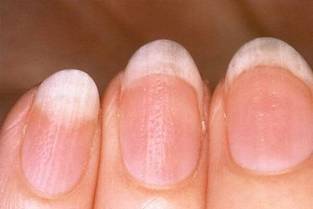
Nail psoriasis, like toenails, has a lot of unpleasant symptoms. Below you can see photos that show what psoriasis looks like on your legs and nails. So consider the manifestations of the disease, depending on its form.
Thimble-type psoriasis has the following symptoms:
- appearance of grooves, depressions in the form of points;
- disk blur;
- externally the plate bends and takes the form of a hook; When you press
- , you notice pain.
Onicolysis:
- change the disc color;
- nail distortion, violation of its integrity;
- Remove the disc from your finger body.
Bloods:
- appearance of red, brown and cyanotic spots under the nail;
- distortion of the shape of the disk, cloudiness; damage to
- capillaries;
- may be purulent discharge when pressed.
Symptoms may vary slightly depending on the severity of the disease and the individual patient.
How to treat nail psoriasis
Is the treatment of nail psoriasis quite topical today? There are many ways to treat the disease in modern medical practice. The most important are:
- using external products.
- Oral medication.
- Use of phototherapy and other physical treatments.
- Apply traditional medicine.
We then suggest that you consider each method in more detail.
Treat nail psoriasis with creams and ointments
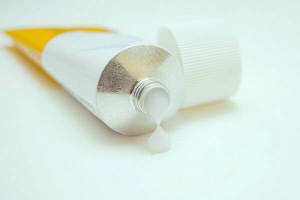
Topical agents are used in the treatment of psoriasis and early medical treatment of nails.
Ointments can be hormonal or non-hormonal. The former are used for severe forms of the disease, in cases where non-hormonal drugs are ineffective.
Ointment for hand and foot nail psoriasis can also be non-hormonal. These are drugs that contain zinc, salicylic acid, and so on.
Non-hormonal drugs have minimal side effects, are not addictive, but they take a long time to take. Hormonal drugs have a rapid effect, but can cause many complications.
Oral drug use
Therapy for the disease should be comprehensive. The following treatments can also be used to relieve symptoms and repair nails:
- Sedatives.
- Immunomodulators. Medicines promote a person’s natural defenses.
- Antiallergic drugs.
Physiotherapy
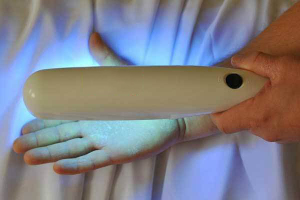
Recently, the use of physiotherapy methods has proved very well. Ultraviolet treatment, as well as the use of methods such as cryotherapy, azotherapy, and excimer laser treatment give excellent results. The following physical treatments are most commonly used in medical practice:
- UV irradiation;
- PUVA therapy;
- X-ray therapy;
- use of ultrasound;
- laser treatment.
Important! The duration and number of sessions should be determined by an experienced professional. Self-medication using these methods is strictly prohibited, as it often causes many side effects.
The role of traditional medicine
The treatment of nail psoriasis with folk remedies has long been used as a comprehensive type of therapy. So, how to cure nail psoriasis at home, we will find out below. There are several recipes to help you cope with the symptoms of the pathology. The most popular medications are:
Celandine decoction
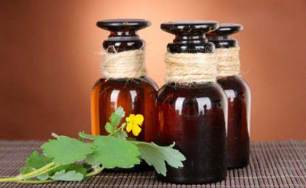
2 tablespoons are required for 500 ml of water. l. herbs. Bring to a boil over low heat, cook for 30-40 minutes. The broth is used for baths, dissolved in water in a ratio of 1: 2, and the nails are immersed in it for 20-25 minutes.
Treating psoriasis on nails with natural oils
Sea buckthorn oil removes inflammation very well. It softens the affected areas, enriches the nails with useful vitamins and minerals. To do this, apply the oil to the plates with a cotton pad and leave for 30-40 minutes. The procedure is repeated 2-3 times a day.
Attention! If you decide to treat your nail psoriasis alone, see a doctor beforehand, self-healing can harm your health!
Using the bow
The fresh onion is passed through a meat grinder, and the resulting crumb is applied to the affected nails. I cover it with a gauze bandage and leave it for 30 minutes. The cure lasts until the healthy nails grow back. Psoriasis of the nails is called a serious chronic disease. It is very important to diagnose the disease in time and start the necessary treatment. This will help keep your feet and hands healthy and avoid unpleasant complications.























